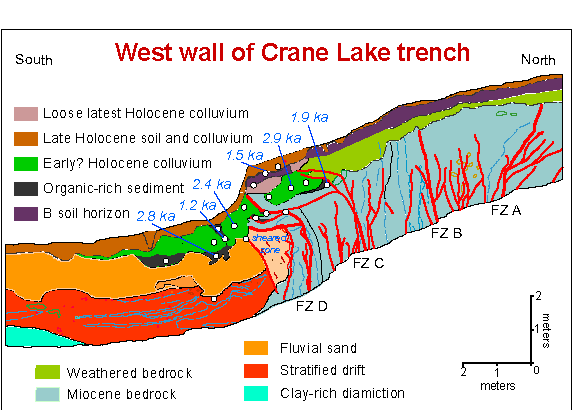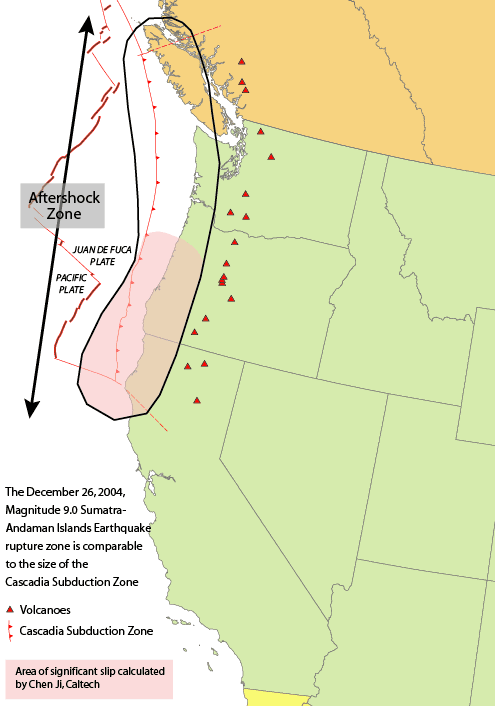|
Paleoseismology
Paleoseismology looks at geologic sediments and rocks, for signs of ancient earthquakes. It is used to supplement seismic monitoring, for the calculation of seismic hazard. Paleoseismology is usually restricted to geologic regimes that have undergone continuous sediment creation for the last few thousand years, such as swamps, lakes, river beds and shorelines. In this typical example, a trench is dug in an active sedimentation regime. Evidence of thrust faulting can be seen in the walls of the trench. It becomes a matter of deducting the relative age of each fault, by cross-cutting patterns. The faults can be dated in absolute terms, if there is dateable carbon, or human artifacts. Many notable discoveries have been made using the techniques of paleoseismology. For example, there is a common misconception that having many smaller earthquakes can somehow 'relieve' a major fault such as the San Andreas Fault, and reduce the chance of a major earthquake. It is now known (u ... [...More Info...] [...Related Items...] OR: [Wikipedia] [Google] [Baidu] |
Archaeoseismology
Archaeoseismology is the study of past earthquakes deriving from the analysis of archaeological sites. Such analyses reveal information about seismic events that have not been historically recorded. Such data can also help to document seismic risk in areas subject to extremely destructive earthquakes. In 1991, an international conference held in Athens marked the beginning of modern research in the field of archaeoseismology, described as a "study of ancient earthquakes, and their social, cultural, historical and natural effects". The main idea Earthquakes that happened during the far past hide a particularly important information for a regional seismic risk assessment. We have quantitative data concerning past earthquakes only from the beginning of the 20 century (as the invention of the seismograph is from the very late 19 century), but humanity is forced to deal with earthquakes since the very beginning of its time. So, we have an extremely limited information to deal with a reli ... [...More Info...] [...Related Items...] OR: [Wikipedia] [Google] [Baidu] |
Cascadia Subduction Zone
The Cascadia subduction zone is a convergent plate boundary that stretches from northern Vancouver Island in Canada to Northern California in the United States. It is a very long, sloping subduction zone where the Explorer, Juan de Fuca, and Gorda plates move to the east and slide below the much larger mostly continental North American Plate. The zone varies in width and lies offshore beginning near Cape Mendocino, Northern California, passing through Oregon and Washington, and terminating at about Vancouver Island in British Columbia. The Explorer, Juan de Fuca, and Gorda plates are some of the remnants of the vast ancient Farallon Plate which is now mostly subducted under the North American Plate. The North American Plate itself is moving slowly in a generally southwest direction, sliding over the smaller plates as well as the huge oceanic Pacific Plate (which is moving in a northwest direction) in other locations such as the San Andreas Fault in central and southern Califo ... [...More Info...] [...Related Items...] OR: [Wikipedia] [Google] [Baidu] |
Moment Magnitude Scale
The moment magnitude scale (MMS; denoted explicitly with or Mw, and generally implied with use of a single M for magnitude) is a measure of an earthquake's magnitude ("size" or strength) based on its seismic moment. It was defined in a 1979 paper by Thomas C. Hanks and Hiroo Kanamori. Similar to the local magnitude scale, local magnitude/Richter scale () defined by Charles Francis Richter in 1935, it uses a logarithmic scale; small earthquakes have approximately the same magnitudes on both scales. Despite the difference, news media often says "Richter scale" when referring to the moment magnitude scale. Moment magnitude () is considered the authoritative magnitude scale for ranking earthquakes by size. It is more directly related to the energy of an earthquake than other scales, and does not saturate—that is, it does not underestimate magnitudes as other scales do in certain conditions. It has become the standard scale used by seismological authorities like the U.S. Geological ... [...More Info...] [...Related Items...] OR: [Wikipedia] [Google] [Baidu] |
Seismite
{{Earthquakes Seismites are sedimentary beds and structures deformed by seismic shaking. The German paleontologist Adolf Seilacher first used the term in 1969 to describe earthquake-deformed layers. Today, the term is applied to both sedimentary ''layers'' and soft sediment deformation ''structures'' formed by shaking. This subtle change in usage accommodates structures that may not remain within a layer (i.e., clastic dikes or sand volcanos). Caution is urged when applying the term to features observed in the field, as similar-looking features may be products of either seismic or non-seismic perturbation. Several informal classification systems exist to help geologists distinguish seismites from other soft-sediment deformation features, though a formal, standardized system has not been developed. Geologists use seismites, in combination with other evidence, to better understand the earthquake history of an area. If age and distribution of seismically-generated features can be d ... [...More Info...] [...Related Items...] OR: [Wikipedia] [Google] [Baidu] |
Paleotempestology
Paleotempestology is the study of past tropical cyclone activity by means of geological proxies as well as historical documentary records. The term was coined by American meteorologist Kerry Emanuel. The usual approach in paleotempestology is the identification of deposits left by storms. Most commonly, these are overwash deposits in waterbodies close to the coast; other means are oxygen isotope ratio variations caused by tropical cyclone rainfall in trees or speleothems (cave deposits), and identifying beach ridges kicked up by storm waves. The occurrence rate of tropical cyclones can then be inferred from these deposits and sometimes also their intensity – typically the stronger events are the most easily recognizable ones –, by comparing them to deposits left by historical events. Paleotempestological research has shown that in the Coast of the Gulf of Mexico and in Australia, the occurrence rate of intense tropical cyclones is about once every few centuries, and there ... [...More Info...] [...Related Items...] OR: [Wikipedia] [Google] [Baidu] |
Subduction
Subduction is a geological process in which the oceanic lithosphere is recycled into the Earth's mantle at convergent boundaries. Where the oceanic lithosphere of a tectonic plate converges with the less dense lithosphere of a second plate, the heavier plate dives beneath the second plate and sinks into the mantle. A region where this process occurs is known as a subduction zone, and its surface expression is known as an arc-trench complex. The process of subduction has created most of the Earth's continental crust. Rates of subduction are typically measured in centimeters per year, with the average rate of convergence being approximately two to eight centimeters per year along most plate boundaries. Subduction is possible because the cold oceanic lithosphere is slightly denser than the underlying asthenosphere, the hot, ductile layer in the upper mantle underlying the cold, rigid lithosphere. Once initiated, stable subduction is driven mostly by the negative buoyancy of the de ... [...More Info...] [...Related Items...] OR: [Wikipedia] [Google] [Baidu] |
Tsunami
A tsunami ( ; from ja, 津波, lit=harbour wave, ) is a series of waves in a water body caused by the displacement of a large volume of water, generally in an ocean or a large lake. Earthquakes, volcanic eruptions and other underwater explosions (including detonations, landslides, glacier calvings, meteorite impacts and other disturbances) above or below water all have the potential to generate a tsunami. Unlike normal ocean waves, which are generated by wind, or tides, which are in turn generated by the gravitational pull of the Moon and the Sun, a tsunami is generated by the displacement of water from a large event. Tsunami waves do not resemble normal undersea currents or sea waves because their wavelength is far longer. Rather than appearing as a breaking wave, a tsunami may instead initially resemble a rapidly rising tide. For this reason, it is often referred to as a tidal wave, although this usage is not favoured by the scientific community because it might give ... [...More Info...] [...Related Items...] OR: [Wikipedia] [Google] [Baidu] |
1700 Cascadia Earthquake
The 1700 Cascadia earthquake occurred along the Cascadia subduction zone on January 26, 1700, with an estimated moment magnitude of 8.7–9.2. The megathrust earthquake involved the Juan de Fuca Plate from mid-Vancouver Island, south along the Pacific Northwest coast as far as northern California. The length of the fault rupture was about , with an average slip of . The earthquake caused a tsunami which struck the west coast of North America and the coast of Japan. Japanese tsunami records, along with reconstructions of the wave moving across the ocean, put the earthquake at about 9pm on the evening of 26 January 1700. Evidence The earthquake took place at about 21:00 Pacific Time on January 26, 1700 ( NS). Although there are no written records for the region from the time, the timing of the earthquake has been inferred from Japanese records of a tsunami that does not correlate with any other Pacific Rim quake. The Japanese records exist primarily in the modern-day Iwate Pre ... [...More Info...] [...Related Items...] OR: [Wikipedia] [Google] [Baidu] |




